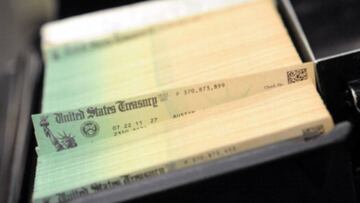How much are the stimulus supplemental payments for the 2020 Tax Filers?
The IRS has sent out around 165 million stimulus payments in the third round of Economic Impact Payments, over six million of them “plus-up” payments.

The Internal Revenue Service (IRS) began sending out $1,400 stimulus checks the day after President Biden signed the American Rescue Plan which authorized the disbursement. The majority of expected payments have now been sent but as the tax agency processes 2020 tax returns it will continue to send out additional payments.
The American Rescue Plan was enacted before the majority of Americans had filed taxes, with just 58 million returns processed the day the first payments were sent out. In order to expedite the payments to Americans the IRS based the amount sent to households on their 2019 tax return if the 2020 tax return hadn’t been processed yet. As the agency processes returns and updates information some households have become eligible for a larger payment than was sent triggering a supplemental or “plus-up” payment.
Also see:
- Continued calls for additional stimulus checks
- “Automatic stabilizers" could trigger fourth stimulus check
- Is there a limit on Child Tax Credit claims?
- How many households will get the new Child Tax Credit?
The average “plus-up” payment is around $2,100
The IRS sent the first supplemental payments in the third batch of Economic Impact Payments that were distributed at the beginning of April. These payments went to taxpayers who saw their income drop in 2020 compared to 2019 or had a new child or dependent on their 2020 tax return among other situations. Since the first batch with “plus-up" payments, the agency has sent seven more and will continue the weekly supplemental payments as it receives and processes 2020 tax returns.
The initial batch of “plus-up” payments resulted in the largest of block of payments and which averaged over $2,800 per payment. However, the average supplemental payment in the last batch was $1,740 based on IRS data. In all around six million “plus-up” payments have been sent for a worth of approximately $13 billion.
Check your tax refund status, make a payment, find free help, sign up for tax tips, and more from IRS2Go, the official #IRS mobile app. Download it now as you #GetReady for filing season: https://t.co/jqXsBGvn48 pic.twitter.com/4TTvYbjLVo
— IRSnews (@IRSnews) May 17, 2021
The IRS is sending first time stimulus checks weekly
When the IRS began the “plus-up” payments another group also started receiving their $1,400 stimulus checks, those who the agency didn’t have information on previously but filed a tax return and qualified for a payment. In the fall millions of people that should have qualified for a $1,200 stimulus payment still hadn’t gotten their stimulus check.
Many of these people were homeless or non-filers, taxpayers who aren’t required to file a tax return because of their low-income. As the IRS receives and processes 2020 tax returns it will send out payments to these people on a weekly basis.
The #IRS Where’s My Refund? tool displays your refund status in three phases. The tool is updated once every 24 hours, usually overnight, so there's no need to check your refund status more often. Get started at: https://t.co/PFiedQsvmp pic.twitter.com/r1twoxJxVw
— IRSnews (@IRSnews) May 18, 2021
How to check your stimulus payment
Related stories
If you’re a first-time tax filer you probably want to check whether the IRS has processed your 2020 tax return first. You can check using the agency’s Where’s My Refund? online tool or the mobile app IRS2Go to follow the status of your return. If you filed electronically information on your tax return will be available within 24 hours but if you filed by mail you will need to wait at least four weeks.
To follow the progress of your stimulus check payment you can use the IRS online tool Get My Payment. The IRS updates information on the status of refunds and stimulus payments once a day, typically overnight.
- IRS
- Coronavirus stimulus checks
- USA coronavirus stimulus checks
- Covid-19 economic crisis
- Science
- Coronavirus Covid-19
- Economic crisis
- Inland Revenue
- Taxes
- Pandemic
- Coronavirus
- Recession
- Tributes
- Economic climate
- Virology
- Outbreak
- Infectious diseases
- Public finances
- Microbiology
- Diseases
- Medicine
- Economy
- Finances
- Biology
- Health


